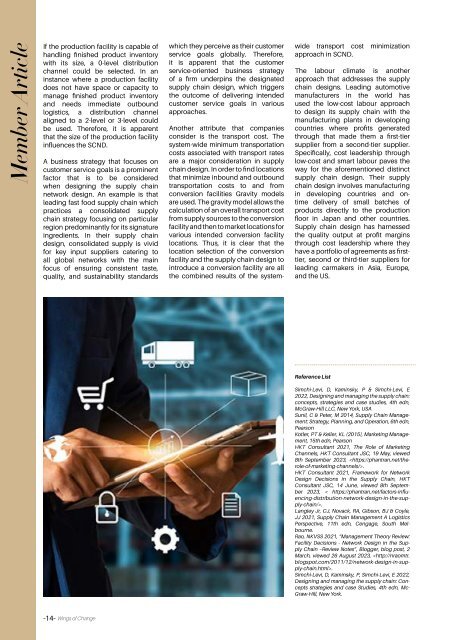Wings of Change Newsletter October 2023
The 9th edition of the newsletter from WiLAT
The 9th edition of the newsletter from WiLAT
Create successful ePaper yourself
Turn your PDF publications into a flip-book with our unique Google optimized e-Paper software.
Member Article<br />
If the production facility is capable <strong>of</strong><br />
handling finished product inventory<br />
with its size, a 0-level distribution<br />
channel could be selected. In an<br />
instance where a production facility<br />
does not have space or capacity to<br />
manage finished product inventory<br />
and needs immediate outbound<br />
logistics, a distribution channel<br />
aligned to a 2-level or 3-level could<br />
be used. Therefore, it is apparent<br />
that the size <strong>of</strong> the production facility<br />
influences the SCND.<br />
A business strategy that focuses on<br />
customer service goals is a prominent<br />
factor that is to be considered<br />
when designing the supply chain<br />
network design. An example is that<br />
leading fast food supply chain which<br />
practices a consolidated supply<br />
chain strategy focusing on particular<br />
region predominantly for its signature<br />
ingredients. In their supply chain<br />
design, consolidated supply is vivid<br />
for key input suppliers catering to<br />
all global networks with the main<br />
focus <strong>of</strong> ensuring consistent taste,<br />
quality, and sustainability standards<br />
which they perceive as their customer<br />
service goals globally. Therefore,<br />
it is apparent that the customer<br />
service-oriented business strategy<br />
<strong>of</strong> a firm underpins the designated<br />
supply chain design, which triggers<br />
the outcome <strong>of</strong> delivering intended<br />
customer service goals in various<br />
approaches.<br />
Another attribute that companies<br />
consider is the transport cost. The<br />
system-wide minimum transportation<br />
costs associated with transport rates<br />
are a major consideration in supply<br />
chain design. In order to find locations<br />
that minimize inbound and outbound<br />
transportation costs to and from<br />
conversion facilities Gravity models<br />
are used. The gravity model allows the<br />
calculation <strong>of</strong> an overall transport cost<br />
from supply sources to the conversion<br />
facility and then to market locations for<br />
various intended conversion facility<br />
locations. Thus, it is clear that the<br />
location selection <strong>of</strong> the conversion<br />
facility and the supply chain design to<br />
introduce a conversion facility are all<br />
the combined results <strong>of</strong> the systemwide<br />
transport cost minimization<br />
approach in SCND.<br />
The labour climate is another<br />
approach that addresses the supply<br />
chain designs. Leading automotive<br />
manufacturers in the world has<br />
used the low-cost labour approach<br />
to design its supply chain with the<br />
manufacturing plants in developing<br />
countries where pr<strong>of</strong>its generated<br />
through that made them a first-tier<br />
supplier from a second-tier supplier.<br />
Specifically, cost leadership through<br />
low-cost and smart labour paves the<br />
way for the aforementioned distinct<br />
supply chain design. Their supply<br />
chain design involves manufacturing<br />
in developing countries and ontime<br />
delivery <strong>of</strong> small batches <strong>of</strong><br />
products directly to the production<br />
floor in Japan and other countries.<br />
Supply chain design has harnessed<br />
the quality output at pr<strong>of</strong>it margins<br />
through cost leadership where they<br />
have a portfolio <strong>of</strong> agreements as firsttier,<br />
second or third-tier suppliers for<br />
leading carmakers in Asia, Europe,<br />
and the US.<br />
Reference List<br />
Simchi-Levi, D, Kaminsky, P & Simchi-Levi, E<br />
2022, Designing and managing the supply chain:<br />
concepts, strategies and case studies, 4th edn,<br />
McGraw-Hill LLC, New York, USA<br />
Sunil, C & Peter, M 2014, Supply Chain Management:<br />
Strategy, Planning, and Operation, 6th edn,<br />
Pearson<br />
Kotler, PT & Keller, KL (2015), Marketing Management,<br />
15th edn, Pearson<br />
HKT Consultant 2021, The Role <strong>of</strong> Marketing<br />
Channels, HKT Consultant JSC, 19 May, viewed<br />
8th September <strong>2023</strong>, .<br />
HKT Consultant 2021, Framework for Network<br />
Design Decisions in the Supply Chain, HKT<br />
Consultant JSC, 14 June, viewed 8th September<br />
<strong>2023</strong>, < https://phantran.net/factors-influencing-distribution-network-design-in-the-supply-chain/>.<br />
Langley Jr, CJ, Novack, RA, Gibson, BJ & Coyle,<br />
JJ 2021, Supply Chain Management A Logistics<br />
Perspective, 11th edn, Cengage, South Melbourne.<br />
Rao, NKVSS 2021, “Management Theory Review:<br />
Facility Decisions - Network Design in the Supply<br />
Chain –Review Notes”, Blogger, blog post, 2<br />
March, viewed 26 August <strong>2023</strong>, .<br />
Simchi-Levi, D, Kaminsky, P, Simchi-Levi, E 2022,<br />
Designing and managing the supply chain: Concepts<br />
strategies and case Studies, 4th edn, Mc-<br />
Graw-Hill, New York.<br />
-14- <strong>Wings</strong> <strong>of</strong> <strong>Change</strong>
















